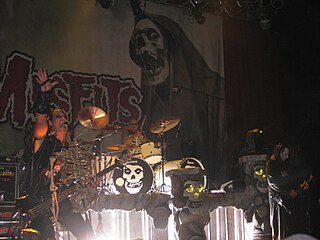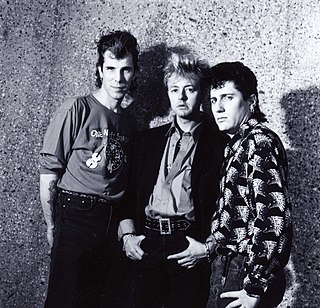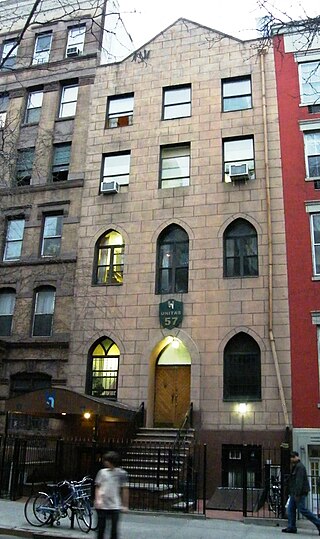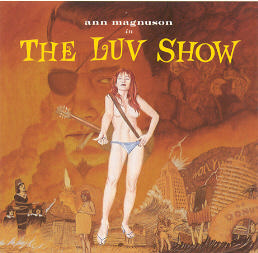
Jeffrey Ross Hyman, known professionally as Joey Ramone, was an American singer, songwriter, and the lead vocalist and founding member of the punk rock band Ramones, along Johnny Ramone and Dee Dee Ramone. His image, voice, and tenure with the Ramones made him a countercultural icon.

The Police were an English rock band formed in London in 1977. Within a few months of their first gig, the line-up settled as Sting, Andy Summers (guitar) and Stewart Copeland, and this remained unchanged for the rest of the band's history. The Police became globally popular from the late 1970s to the mid-1980s. Emerging in the British new wave scene, they played a style of rock influenced by punk, reggae, and jazz.

Glenn Branca was an American avant-garde composer, guitarist, and luthier. Known for his use of volume, alternative guitar tunings, repetition, droning, and the harmonic series, he was a driving force behind the genres of no wave, totalism and noise rock. Branca received a 2009 Foundation for Contemporary Arts Grants to Artists Award.

The Misfits are an American punk rock band often recognized as the pioneers of the horror punk subgenre, blending punk and other musical influences with horror film themes and imagery. The group was founded in 1977 in Lodi, New Jersey, by vocalist, songwriter and keyboardist Glenn Danzig. Over the next six years, Danzig and bassist Jerry Only were the group's main members through numerous personnel changes. During this period, they released several EPs and singles, and with Only's brother Doyle as guitarist, the albums Walk Among Us (1982) and Earth A.D./Wolfs Blood (1983), both considered touchstones of the early-1980s hardcore punk movement. The band has undergone many lineup changes over the years, with bassist Jerry Only being the group's only constant member.

Gang of Four are an English post-punk band, formed in 1976 in Leeds. The original members were singer Jon King, guitarist Andy Gill, bass guitarist Dave Allen and drummer Hugo Burnham. There have been many different line-ups including, among other notable musicians, Sara Lee, Gail Ann Dorsey, and David Pajo. After a brief lull in the 1980s, different constellations of the band recorded two studio albums in the 1990s. Between 2004 and 2006 the original line-up was reunited; Gill toured using the name between 2012 and his death in 2020. In 2021, the band announced that King, Burnham, and Lee would be reuniting for a US tour in 2022 with David Pajo on guitar and Sara Lee returning to the band. They continue to perform live, including at the Cruel World Festival in Pasadena, California; headlining Luna Fest in Coimbra, Portugal, a UK Tour in October '23, and plan to be in Australia and beyond in 2024.

Stray Cats are an American rockabilly band formed in 1979 by guitarist and vocalist Brian Setzer, double bassist Lee Rocker, and drummer Slim Jim Phantom in the Long Island town of Massapequa, New York. The group had numerous hit singles in the UK, Australia, Canada, and the U.S. including "Stray Cat Strut", "(She's) Sexy + 17", "Look at That Cadillac", "I Won't Stand in Your Way", "Bring It Back Again", and "Rock This Town", which the Rock and Roll Hall of Fame has listed as one of the songs that shaped rock and roll.

The Go-Go's are an American all-female rock band formed in Los Angeles in 1978. Except for short periods when other musicians joined briefly, the band has had a relatively stable lineup consisting of Charlotte Caffey on lead guitar and keyboards, Belinda Carlisle on lead vocals, Gina Schock on drums, Kathy Valentine on bass, and Jane Wiedlin on rhythm guitar.

The Dead Milkmen is an American punk rock band formed in 1983 in Philadelphia. Their original lineup consisted of vocalist and keyboardist Rodney Linderman, guitarist and vocalist Joe Genaro, bassist Dave Schulthise and drummer Dean Sabatino.
Bongwater was an American psychedelic rock band, which formed in 1987 and dissolved in 1992. The group was founded by Ann Magnuson and Mark Kramer, who had worked together previously in Pulsallama. The group also featured drummer David Licht and guitarists Dave Rick and later Randolph A. Hudson III. Guests included Fred Frith, Peter Stampfel and Fred Schneider.
Bush Tetras are an American post-punk No Wave band from New York City, formed in 1979. They are best known for the 1980 song "Too Many Creeps", which exemplified the band's sound of "jagged rhythms, slicing guitars, and sniping vocals". Although they did not achieve mainstream success, the Bush Tetras were influential and popular in the Manhattan club scene and college radio in the early 1980s. New York's post-punk revival of the 2000s was accompanied by a resurgence of interest in the genre, with the Tetras' influence heard in many of that scene's bands.

U.K. Subs are an English punk rock band, among the earliest in the first wave of British punk. Formed in 1976, the mainstay of the band has been vocalist Charlie Harper, originally a singer in Britain's R&B scene. One of the first hardcore punk bands, elements of rhythm and blues music - including harmonica - also remained an occasional element of their work.

More Fun in the New World is the fourth studio album by American rock band X, released in 1983 by Elektra Records. It was reissued with four bonus tracks by Rhino Records in 2002 and was the final X album produced by Ray Manzarek. The band supported the album with a North American tour.

Ann Magnuson is an American actress, performance artist, and nightclub performer. She was described by The New York Times in 1990 as "An endearing theatrical chameleon who has as many characters at her fingertips as Lily Tomlin does".

Club 57 was a nightclub located at 57 St. Mark's Place in the East Village, New York City during the late 1970s and early 1980s. It was originally founded by Stanley Zbigniew Strychacki as well as Dominic Rose, then enhanced by nightclub performer Ann Magnuson, Susan Hannaford, and poet Tom Scully. It was a hangout and venue for performance and visual artists and musicians, including The Cramps, Madonna, Keith Haring, Cyndi Lauper, Charles Busch, Klaus Nomi, The B-52s, RuPaul, Futura 2000, Tron von Hollywood, Kenny Scharf, Frank Holliday, John Sex, Wendy Wild, The Fall, April Palmieri, Peter Kwaloff, Robert Carrithers, The Fleshtones, The Fuzztones, Joey Arias, Lypsinka, Michael Musto, Marc Shaiman, Scott Wittman, Fab Five Freddy, Jacek Tylicki, and to a lesser extent, Jean-Michel Basquiat.
Wendy Wild was an American singer, musician, and artist who in the 1980s was a well-known presence in New York's downtown music and performance scenes.

The Luv Show is an album by the American musician Ann Magnuson. It was released in 1995 on Geffen Records. Magnuson later developed a stage production based on the album.

William Michael Albert Broad, known professionally as Billy Idol, is an English punk singer, songwriter, musician and actor. He achieved fame in the 1970s emerging from the London punk rock scene as the lead singer of the group Generation X. Subsequently, he embarked on a solo career which led to international recognition and made Idol a lead artist during the MTV-driven "Second British Invasion" in the US.
April Palmieri is an American photographer and musician who performed with a 12-piece all-woman percussion band, Pulsallama. During the early 1980s, the band played at such venues as the Mudd Club, the Pyramid, Danceteria, and Club 57 in New York's East Village. Palmieri's photography from this era, including of Keith Haring and John Sex, has been included in an exhibition at the Tate Liverpool and an exhibition at the Museum of Modern Art (MoMA).
The Cyclones were a rock and roll band that helped pioneer the new wave music scene that erupted in the New York City area during the late 70s, early 80s. A female fronted trio, they began as a rockabilly cover band, became an original group in 78/79 which lasted until 1984. Original members included Dan Reich on drums and Walter Sczesny on bass. The group came into its own with addition of singer/guitarist/songwriter Donna Esposito. After a few transitions on bass guitar, the band's stable lineup was complete in late 79/ early 1980 with the addition of Marc Seligman.

Women have made significant contributions to punk rock music and its subculture since its inception in the 1970s. In contrast to the rock music and heavy metal scenes of the 1970s, which were dominated by men, the anarchic, counter-cultural mindset of the punk scene in mid-and-late 1970s encouraged women to participate. This participation played a role in the historical development of punk music, especially in the US and UK at that time, and continues to influence and enable future generations. Women have participated in the punk scene as lead singers, instrumentalists, as all-female bands, zine contributors and fashion designers.
















